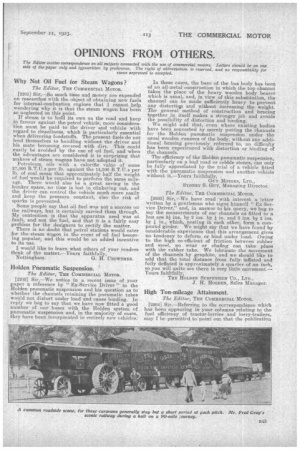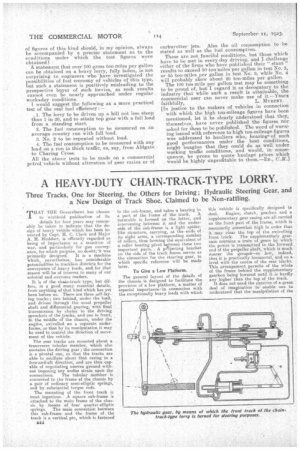OPINIONS FROM OTHERS.
Page 29

Page 30

If you've noticed an error in this article please click here to report it so we can fix it.
The Editor invites correspondence on all subjects connected with the use of commercial motors. Letters should be on one side of the paper only and typewritten by preference. The right of abbreviation is reserved. and no responsibility for views expressed is accepted.
Why Not Oil Fuel for Steam Wagons ?
The Editor, THE COMMERCIAL MOTOR.
[2201) Sir,—,So much time and money are expended on researches with the object a obtaining new fuels for internal-combustion engines that I cannot help wondering why it is that the steam wagon has been so neglected on this point.
If steam is to hold its own on the road and keep in favour against the petrol vehicle, more consideration must be paid to the driver and vehicle with regard to cleanliness, which is particularly essential when delivering foodstuffs. The present fuels do not lend themselves to handling without the driver and his mate becoming covered with dirt. • This could easily b6 avoided by the use of oil fuel, and when the advantages are considered it is surprising that makers of steam wagons have not adopted it. . Petroleum oils with a calorific value of some 27.000 B.T.U.s per lb. against the 14,500 B.T.U.s per lb. of coal mean that approximately half the weisht of fuel would be required to perform the same mileage. There would also be a great saving in the bunker space, no time is lost in clinkering out, and the driver can control the vehicle much more easily and keep the pressure constant, also the risk of sparks is prevented.
Some people say that oil fuel was not a success on the railways, but it certainly carried them through. My contention is that the apparatus used was at fault, and not the fuel, and that it is a fairly easy problem for the designers to rectify the matter.
There is no doubt that petrol stations would cater for the steam wagon in the event of oil fuel becoming popular, and this would be an added incentive to its use.
I would like to learn what others of your readers think of the matter.—Yours faithfully,
Nottingham. G. H. CtROWTHER.
Holden Pneumatic Suspension. 1 The Editor, THE COMMERCIAL MOTOR.
[2202] Sire—We notice in a recent issue of your paper a reference by " Ex-Service Driver" to the Holden pneumatic suspension and his question as to whether the channels retaining the pneumatic tubes would not distort under load and cause binding. In reply we beg to say that we have nowfitted a good number of our buses with the Holden system of pneumatic suspension and, in the majority of cases, they have been incorporated in entirely new vehicles. In these cases, the base of the bus body has been of an all-metal construction in which the top channel takes the place of the heavy wooden body bearer which is usual, and, in view of this substitution, the channel can be made sufficiently heavy to prevent any distortioi and without increasing the weight. The general method of construction and bracing together in itself makes a stronger job and avoids the possibility of distortion and binding. We might add that, even where existing bodies have been converted by merely putting the channels for the Holden pneumatic suspension under the usual wooden runners of the body, without any additional bracing previously referred to, no difficulty has been experienced with distortion or binding of the channels.
The efficiency of the Holden pneumatic suspension, particurarly on a bad road or cobble stones, can only be fully appreciated by the trial of a vehicle fitted with the pneumatic suspension and another vehicle without it.—Yours faithfully,
GUY MOTORS, LTD.,
SYDNEY S. GUY, Managing Director.
The Editor, THE COMMERCIAL MOTOR.
[2203] Sir,—We have read with interest a letter written by a gentleman who signs himself "Ex-Service Driver," and, in answer to his query, we beg to say the measurements of our channels as fitted to a bus are ai ins. by 2 ins, by in. and 3 ins. by 2 ins. by I in., which, nesting in each other, form a compound girder. We mig.ht say that we have found by considerable experience that this arrangement gives no tendency to deform or bind under load. Owing to the high co-efficient of friction between rubber and steel, no wear or chafing can take place with the rubber tube. We lubricate the movement of the channels by graphite, and we should like to add that the total distance from fully inflated and fully deflated is approximately a quarter of an inch, so you will quite see there is very little movement.— Yours faithfully,
THE HOLDEN SUSPENSION CO., LTD.,
J. H. HOLDEN, Sales Manager.
High Ton-mileage Attainment.
The Editor, TUE COMMERCIAL MOTOR.
[2204] Sir,—Referring to the correspondence which has been appearing 'in your columns relating to the fuel efficiency of tractor-lorries and lorry-trailers, May I be permitted to point out that the publication
of figures of this kind should, in my opinion, always • be accompanied by a precise statement as to the conditions under which the test figures were obtained? •
A statement that over 100 gross ton-miles per gallon can be obtained on a heavy lorry, fully laden, is not surprising to engineers who 'have investigated the possibilities of fuel economy of vehicles of this type, but such a statement is positively misleading to the prospective buyer of such lorries, as such results cannot even be nearly approached under regular workaday conditions.
I would suggest the following as a more practical test of the real fuel efficiency:—
The lorry to be driven up a hill not less steep than 1 in 20, and to attain top gear with a full load from a standing start.
2. The fuel consumption to be measured on an average country run with lull load.
3. No. 2 to be•repeated without load.
4. The fuel consumption to be measured with any load on a run in thick traffic, as, say, from Aldgate to Charing Cross.
All the above tests to be made on a commercial petrol vehicle without alteration of gear ratios or of carburetter jets. Also the oil consumption to be stated as well as the fuel consumption. •
These are not fanciful conditions, but those which have to be met in every-day driving, and I challenge -either of the firms who have published their " stunt" results to exceed 80 ton-In-61es per gallon in test No. 2, or 56 ton-miles.per gallon in test No. 3, while No. 4 will probably show about 20 ton-miles per gallon. The 100 ton-mile per gallon test may be something to be proud of, but I regard it as derogatory to the industry that While such a result is attainable, the commercial user can never make use of it.—Yours faithfully, L. MURPHY. {In justice to the makers of. vehicles in connection with -which the high ton-mileage figures have been mentioned, let it be clearly understood that they, themselves, have never published the figures nor asked for them to be published. The word of warning issued with reference to high ton-mileage figures was addressed to hauliers who, hearing., of such good ,performances under. the best conditions,, might imagine that they could do as well under working traffic conditions, and would, in consequence, be prone to quote haulageprices which would be highly tfnprofitable to them.—En., CAL]


































